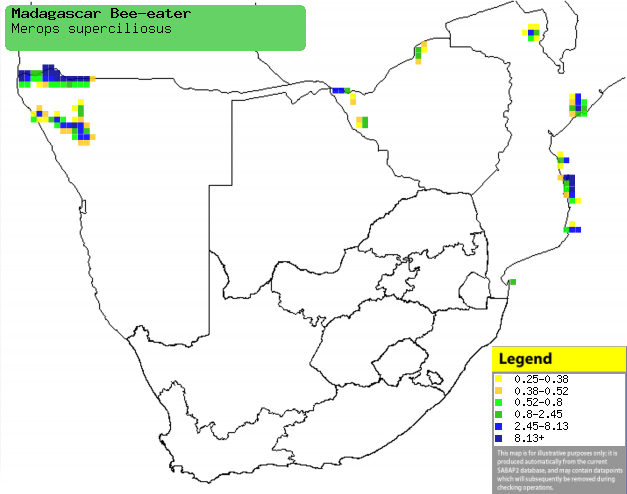|
Merops superciliosus (Madagascar
bee-eater, Olive bee-eater)
Olyfbyvreter [Afrikaans]; Blauwwang-bijeneter [Dutch];
GuÍpier de Madagascar [French]; Madagaskarspint, Madagaskar-bienenfresser
[German]; Abelharuco-olivŠceo [Portuguese]
Life
> Eukaryotes >
Opisthokonta
> Metazoa (animals) >
Bilateria >
Deuterostomia > Chordata >
Craniata > Vertebrata (vertebrates) > Gnathostomata (jawed
vertebrates) > Teleostomi (teleost fish) > Osteichthyes (bony fish) > Class:
Sarcopterygii (lobe-finned
fish) > Stegocephalia (terrestrial
vertebrates) > Tetrapoda
(four-legged vertebrates) > Reptiliomorpha > Amniota >
Reptilia (reptiles) >
Romeriida > Diapsida > Archosauromorpha > Archosauria >
Dinosauria
(dinosaurs) > Saurischia > Theropoda (bipedal predatory dinosaurs) >
Coelurosauria > Maniraptora > Aves
(birds) > Order: Coraciiformes
> Family: Meropidae
The Madagascar bee-eater occupies large areas in Eastern
sub-Saharan Africa, with a smaller population in Namibia and Angola. It prefers
open riverine woodland, coastal plains (especially with mangroves) and wooded
swamps - it is seldom far from water. It is insectivorous, doing most of its
foraging in open areas, hawking insects on the ground and in the air. It lives
in colonies of about 10-30, sometimes even 400 breeding pairs, who dig their
burrows into a riverbank or erosion gully. It lays about 4 eggs, which are
incubated by both sexes. The nestlings stay in the nest for a weeks, eventually
fledging around December.
Distribution and habitat
Occurs from Ethiopia south through Tanzania and eastern DRC
to Angola, Zambia and southern Africa. Within
southern Africa it is common but highly localized, occurring in north-west
Namibia, north-western Zimbabwe amd eastern Mozambique. It generally prefers open riverine woodland, coastal plains (especially with
mangroves) and wooded swamps - it is seldom found far from water.
|
 |
|
Distribution of Madagascar bee-eater in southern Africa,
based on statistical smoothing of the records from first SA Bird Atlas
Project (©
Animal Demography unit, University of
Cape Town; smoothing by Birgit Erni and Francesca Little). Colours range
from dark blue (most common) through to yellow (least common). |
Food
It is insectivorous, doing most of
its foraging in open areas, hawking insects on the ground and in the air. Its
diet has not been studied in southern Africa, however in other areas the
following items have been recorded in its diet:
Breeding
- Monogamous, nesting in
colonies of 10-60 breeding pairs, although a 400 pair colony was once
recorded.
- The nest is excavated by both sexes and consists of a tunnel ending a
egg chamber, typically dug into a riverbank or erosion gullies.
- Egg-laying season is from September-December.
- It lays about four eggs, which are incubated by both sexes.
- Little is known about the chicks, besides that they fledge around
December.
Threats
Not threatened.
References
-
Hockey PAR, Dean WRJ and Ryan PG (eds) 2005. Roberts
- Birds of southern Africa, VIIth ed. The Trustees of the John Voelcker
Bird Book Fund, Cape Town.
|
